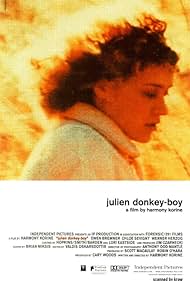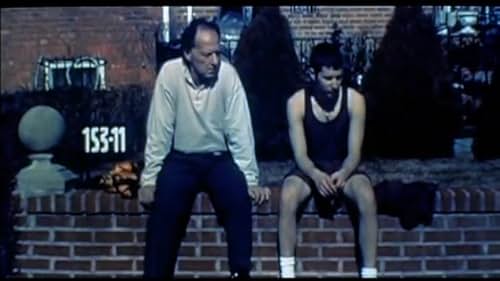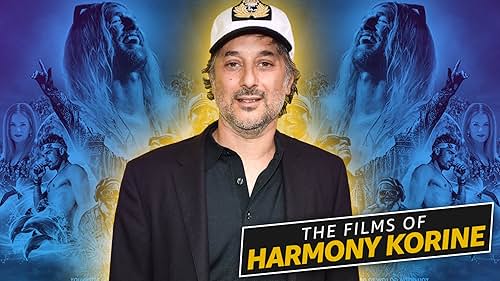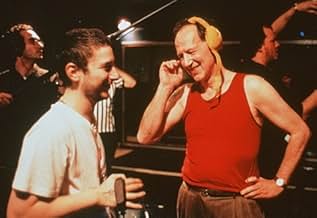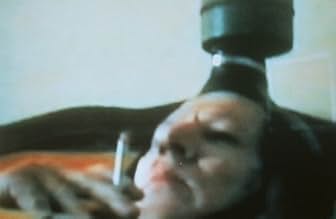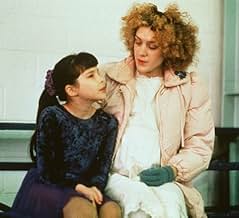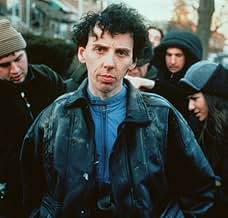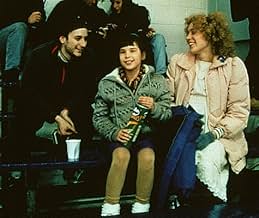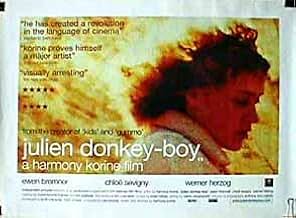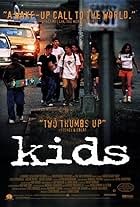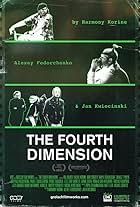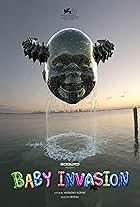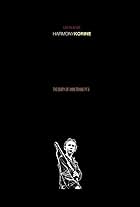VALUTAZIONE IMDb
6,7/10
7879
LA TUA VALUTAZIONE
Un ritratto del degrado della vita di Julien, un ragazzo schizofrenico con un padre prepotente, una sorella incinta di lui, un fratello violento e competitivo e una nonna sconnessa dal mondo... Leggi tuttoUn ritratto del degrado della vita di Julien, un ragazzo schizofrenico con un padre prepotente, una sorella incinta di lui, un fratello violento e competitivo e una nonna sconnessa dal mondo intero.Un ritratto del degrado della vita di Julien, un ragazzo schizofrenico con un padre prepotente, una sorella incinta di lui, un fratello violento e competitivo e una nonna sconnessa dal mondo intero.
- Regia
- Sceneggiatura
- Star
- Premi
- 3 vittorie e 5 candidature
Chloë Sevigny
- Pearl
- (as Chloe Sevigny)
Miriam Martínez
- Teenage Girl
- (as Miriam Martinez)
Olivia Pérez
- Bowler
- (as Olivia Perez)
Trama
Lo sapevi?
- QuizThis is the first American film to be certified by Dogme '95.
- Colonne sonoreO, mio babbino caro
from "Gianni Schicchi"
Composed by Giacomo Puccini
Performed by Brussels Philharmonic (as BRT Philharmonic Orchestra (Brussels))
Soprano: Miriam Gauci
Recensione in evidenza
Harmony Korine's Julien Donkey-Boy, is nothing less than real filmic art. It chronicles a day or so in the life of Julien, a teenage schizophrenic, and the other family members he lives with: his sister, his frustrated and abusive father, played nicely by Werner Herzog, (of all people), his younger brother, and his grandmother.
The effect is like watching Leave it to Beaver on acid--a haunting picture of a family paralyzed by their own dysfunctionality, so pervasive it is that it virtually crushes any hope of what most of us would call a "normal" life. The real tragedy is knowing that we are merely glimpsing a fictional account of what many real families with similar situations have to endure. The film isn't a success solely due to its effectively disturbing chronicle of a mentally ill teen, but rather, HOW it chronicles the life of this character. Korine is a master of using film to communicate story and messages, specifically through the use of editing, cinematography and visual effects. This is amazing, since at only 27, Korine has more visual ownership of the medium than do most directors with twice his experience.
Yet, Korine's movies are not popular. Most people wouldn't have a clue as to what's going on in them. This is because Korine uses visual symbols and other filmic elements to reveal the plot and character development. And he does this masterfully. For example, in one scene, we see the images as if on a videophone, frame-by-frame, with erratic cuts in the action. Yet, the sound flows as normal. Korine uses this technique to symbolize the main character's fragmented view of the world -- a view that is dramatically distorted from our own. This is brilliant filmmaking -- an example of "show, don't tell" yet through use of film form rather than character action.
Indelibly, it is Korine's unconventional film style, of which a good deal looks experimental, yet all of which is handled expertly, that will also keep him at the fringes of the film world, barring him the popularity he deserves. This is too bad since he brings as much to the art of independent film as Scorcese does to the Hollywood film. Yet Korine will never have the accessibility of the other.
In this film, Korine reveals the character of Julien not only through his actions, but via his reactions to those around him and to his environment. This is a hard task for a filmmaker to achieve since those who don't know the particular "reason" for a scene or for its purpose, will be lost. The film demands an aggressive viewer, one who wants to share the boldness of the director's vision, while deciphering it through his or her own knowledge of film conventions and prior knowledge.
Julien Donkey-Boy is not as emotionally powerful as Korine's previous film, Gummo, yet it is just as important in what it has to say about film as a medium of communication, and, about the people who are living at the margins of society.
The effect is like watching Leave it to Beaver on acid--a haunting picture of a family paralyzed by their own dysfunctionality, so pervasive it is that it virtually crushes any hope of what most of us would call a "normal" life. The real tragedy is knowing that we are merely glimpsing a fictional account of what many real families with similar situations have to endure. The film isn't a success solely due to its effectively disturbing chronicle of a mentally ill teen, but rather, HOW it chronicles the life of this character. Korine is a master of using film to communicate story and messages, specifically through the use of editing, cinematography and visual effects. This is amazing, since at only 27, Korine has more visual ownership of the medium than do most directors with twice his experience.
Yet, Korine's movies are not popular. Most people wouldn't have a clue as to what's going on in them. This is because Korine uses visual symbols and other filmic elements to reveal the plot and character development. And he does this masterfully. For example, in one scene, we see the images as if on a videophone, frame-by-frame, with erratic cuts in the action. Yet, the sound flows as normal. Korine uses this technique to symbolize the main character's fragmented view of the world -- a view that is dramatically distorted from our own. This is brilliant filmmaking -- an example of "show, don't tell" yet through use of film form rather than character action.
Indelibly, it is Korine's unconventional film style, of which a good deal looks experimental, yet all of which is handled expertly, that will also keep him at the fringes of the film world, barring him the popularity he deserves. This is too bad since he brings as much to the art of independent film as Scorcese does to the Hollywood film. Yet Korine will never have the accessibility of the other.
In this film, Korine reveals the character of Julien not only through his actions, but via his reactions to those around him and to his environment. This is a hard task for a filmmaker to achieve since those who don't know the particular "reason" for a scene or for its purpose, will be lost. The film demands an aggressive viewer, one who wants to share the boldness of the director's vision, while deciphering it through his or her own knowledge of film conventions and prior knowledge.
Julien Donkey-Boy is not as emotionally powerful as Korine's previous film, Gummo, yet it is just as important in what it has to say about film as a medium of communication, and, about the people who are living at the margins of society.
I più visti
Accedi per valutare e creare un elenco di titoli salvati per ottenere consigli personalizzati
- How long is Julien Donkey-Boy?Powered by Alexa
Dettagli
- Data di uscita
- Paese di origine
- Sito ufficiale
- Lingua
- Celebre anche come
- Dogme # 6 - Julien Donkey-Boy
- Luoghi delle riprese
- Aziende produttrici
- Vedi altri crediti dell’azienda su IMDbPro
Botteghino
- Lordo Stati Uniti e Canada
- 85.400 USD
- Lordo in tutto il mondo
- 92.442 USD
Contribuisci a questa pagina
Suggerisci una modifica o aggiungi i contenuti mancanti

Divario superiore
By what name was Julien Donkey-Boy (1999) officially released in India in English?
Rispondi